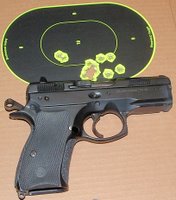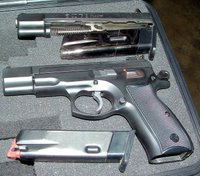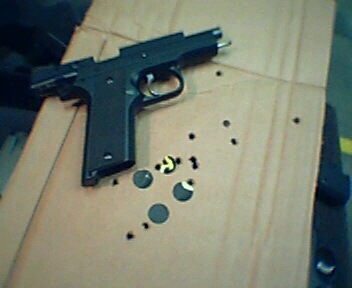I'm guilty.
I'm guilty of buying loads and loads of targets, shooting a generous number of holes in them, then tossing them and putting up a new one.
I'm less guilty, now.
Viewing some of my posts you'll note the use of self-adhesive Shoot N C or Orange Peel targets on cardboard. The cardboard comes from my workplace where they have to pay to have it hauled away as trash so no one cares how much I take away.
I have purchased more formal targets, though. I have some of the ICE-QT targets and I purchased a few silhouette targets. I had not previously learned to use tape to repair these, but now I am. A 1" wide roll of cheap masking tape can prolong the shooting life of a target.
So, I am guilty, but I'm working to reduce my guilt and my expenses. The better to have more money available for ammo, guns and gunsmithing.
Speaking of gunsmithing I just picked up several of my pistols which had been at the gunsmith for an "action job". While this is more about the trigger than the actual performance I highly recommend having a competent gunsmith work on your pistols. Maybe you are adept enough with tools to do a good and safe job but not everyone is.
The work done has greatly improved the trigger on all of my CZs. While none are as good as the trigger on my Witness Stock (which had been done by another gunsmith) the internals of a CZ are different from those on a Witness/Tanfoglio. The pay-off is tighter groups.
I finally got some professional help with another issue I had. I mentioned that kept having problems with my XD SC shooting left to a club member whom I knew carried an XD. I took a look at the way I hold that pistol and diagnosed the problem right away. Too much trigger finger.
I had been using the joint of my finger instead of the pad and because of the shape of the grip and the weight of the XD's trigger I was pulling the gun with my trigger finger.
Shooting the little pistol with just the pad of my trigger finger brought the rounds back to center line with my point of aim.
I'll need to practice this method more, I think so I use it consistently with all my pistols. It could improve my group sizes on all of them or at worst not make the groups any larger.
Sunday, October 22, 2006
Sunday, September 24, 2006
Going Long
Sorry, no images for this post. I didn't bring my camera and decided not to lug the targets home to snap pics of them.
Yesterday at my club they held a 2700 match. That got me thinking that I should start working toward shooting some bullseye. When I went in today there were flyers for a 2700 league running the winter months on Monday nights.
I'm seriously considering doing so. Toward that end I broke out some of my lesser used guns and started trying my hand at the full 75 feet.
I have a 686 with a six inch barrel. The former owner had gotten Wolff springs into it and the trigger is sweet. Sooo sweet. You could rot your teeth if you don't brush and floss after shooting.
That's one candidate. Considering that I have bad eyesight I feel pretty good about shooting 4 out of 6 into the black on a Dirty Bird 8" on my first try.
My Mk III Hunter is doing 7 out of10 into a similar target.
These are after I had already been playing at shooting one-handed with my two 1911 clones and my CZ 97 at 50 feet. What did I find out? I found out that at 50 feet I think the 97 outshoots my 1911s, even with it having fixed sights. The group was certainly better and I shot it last, not first. It's still in the running to play at this game. I will have to see how I do with it at 25 yards next time. If I have to aim off then I have to.
I still have to check the rules, too. I know they allow red dot sights but I don't know if optical magnification sights are allowed. Might improve my shooting. For now I'll keep practicing with iron sights.
I'll keep this blog up to date with my efforts if I decide to participate in the league.
Yesterday at my club they held a 2700 match. That got me thinking that I should start working toward shooting some bullseye. When I went in today there were flyers for a 2700 league running the winter months on Monday nights.
I'm seriously considering doing so. Toward that end I broke out some of my lesser used guns and started trying my hand at the full 75 feet.
I have a 686 with a six inch barrel. The former owner had gotten Wolff springs into it and the trigger is sweet. Sooo sweet. You could rot your teeth if you don't brush and floss after shooting.
That's one candidate. Considering that I have bad eyesight I feel pretty good about shooting 4 out of 6 into the black on a Dirty Bird 8" on my first try.
My Mk III Hunter is doing 7 out of10 into a similar target.
These are after I had already been playing at shooting one-handed with my two 1911 clones and my CZ 97 at 50 feet. What did I find out? I found out that at 50 feet I think the 97 outshoots my 1911s, even with it having fixed sights. The group was certainly better and I shot it last, not first. It's still in the running to play at this game. I will have to see how I do with it at 25 yards next time. If I have to aim off then I have to.
I still have to check the rules, too. I know they allow red dot sights but I don't know if optical magnification sights are allowed. Might improve my shooting. For now I'll keep practicing with iron sights.
I'll keep this blog up to date with my efforts if I decide to participate in the league.
Sunday, September 17, 2006
Tried a Sig

I got a chance to try out some other models of handgun today. A friend at the range had brought along a Sig 226 I didn't even know he owned and his CZ 85. Not an 85B. It's pre-B.
I like how the Sig fills my hand but I was NOT impressed with it for shooting accuracy. I'm shooting smaller groups with my P 01 with the trigger still not smoothed out. It's massive, for a 9mm. Glad I got to shoot one without sinking money into it. I can buy a CZ and have money left over for ammo for what a Sig costs new.
The 85 shot better (naturally). The main features that distinguish an 85 from the 75 are ambidextrous safety and slide release. The 85 is supposed to come with a drop-free magazine brake but I guess this one pre-dated that decision.
He had a Pachmayer grip on it which is superior to the hard plastic which would have been original to the pre-B 85 but in my opinion is not superior to CZ's current soft rubber grip panels.
I have seen the wonderful work of Omega and Hakan Pek for CZ grips. I even have a very nice set of wooden grips for my 40 B which the previous owner made. I find, though, that I prefer the soft feeling rubber grips that CZ is putting on their handguns lately.
The softer rubber adds grip power. If your hands get sweaty it only grips more.
Friday, September 15, 2006
The Kadet Kit

I enjoy shooting, but I view it as training. Towards that end I've developed a pattern to my training that I've been fairly consistent with.
I start off with my CZ 75B topped with a Kadet Kit.
For those unfamiliar with them the Kadet Kit is an "upper" plus magazines that fit the 75/85 family. It fires 22 LR rounds. It functions exactly like the proper top end, it just fires the inexpensive and mild 22 LR.
You can by the Kadet as a whole pistol but then you have nothing but a 22. You would have to go and buy a 75/85 if you also want the ability to fire centerfire cartridges. By buying the 9mm or .40 75/85 and a Kadet Kit you wind up with one gun that fires two different rounds.
The balance of the pistol remains the same. If you have trigger work done on your 75 then you have the same trigger when you go to fire the Kadet Kit.
With almost no recoil the Kadet Kit gives you a very practical training tool.
I generally fire 25-50 22 LR rounds through my Kadet before switching to the 9mm. There is a big difference between the recoil but if you get used to not having the pistol jump then you aren't anticipating the recoil. You can work on getting rid of any tendency to flinch.
After swapping to the 9mm I fire 20-50 rounds through the 75, then switch to the smaller framed 9s like the P 01.
I've heard it from men I respect that one should not fire more than 50 rounds, but they also explain that it's 50 rounds from the same gun when training. The Kadet Kit rounds don't count against the 9mm rounds from the 75. The rounds fired from the 75 don't count against the ones from the P 01. By having multiple guns I can train longer. I generally put the guns away when my form starts to dissolve and my groups are getting larger. PERFECT practice makes perfect. Practicing when you are too tired only reinforces bad habits.
Right now I'm trying to shoot each firearm to as tight a group as I can. This forces me to work on proper grip and trigger control. As I've said before I have been shooting at 50 feet but I've also backed up to 25 feet to see the results. Shooting at longer range is helping me to tighten up on the closer targets, too.
Saturday, September 09, 2006
The Forty Caliber Flinch


When I first purchased a centerfire sem-auto I picked up a 9mm. Not unusual. It's perhaps the most common. I picked it up and fired it "adequately". Meaning I thought I could shoot better.
I then got a .45. I shot better with it. Not unusual. The old workhorse chambering of 45 ACP is known for accuracy.
Later on I picked up my first .40. I got it because I wanted to try the round that had filled the niche between 9mm and 45 ACP.
I was awful. Really, really awful. Yes, I know I shot it better than other people. I have standards that I apply to myself, though and expect better.
I thought it was the round. That it was inherently inaccurate. I've seen that charge from people who post on website forums. I stopped buying .40 guns, passing up ones that I could have gotten for a reasonable price.
What had happened to me has probably happened to a lot of people. I had developed a horrible flinch. The .40 is usually put into the same frame as a 9mm. It throws out a lot more energy because it throws more lead with each shot. The gun weighs the same as when it is chambered in 9mm but the round is as fast or faster and weighs more. More muzzle energy out of the same weight of firearm equals more recoil/muzzle flip.
Because the .40 is faster than a 45 ACP, even though it weighs less, it can also have more percieved recoil. Usually a handgun chambered for 45 ACP is heavier than a 9mm which helps fight against recoil and muzzle flip. A .40 doesn't usually weigh any more than the same handgun in 9mm.
What I needed wasn't magic. It was a better grip. A better grip and better trigger control. These two solutions brought my group size down from greater than 5" at 25 feet to under 3". It has become so easy to group well at 25 feet that I have switched to shooting at 50 feet.
The forty caliber is not inherently inaccurate. It can be as accurate as any other you can shoot. It can also pack more punch for self-defense or hunting purposes than the 9mm.
The lesson here is to work on grip and trigger control. Your own accuracy can only get better, no matter what caliber you choose to carry.
The images here illustrate what I'm currently shooting like at 50 feet. The ammo is bargain basement quality. I can do better. I will do better. It's just a matter of practicing.
Subscribe to:
Posts (Atom)




